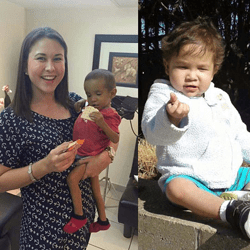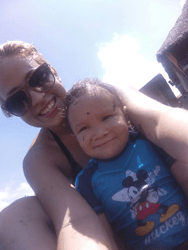 When Dante Diaz Abarca was born in August 2014, in San Salvador, El Salvador, his skin had a yellowish tinge. The cause was hyperbilirubinemia — an excess of bilirubin in the blood.
When Dante Diaz Abarca was born in August 2014, in San Salvador, El Salvador, his skin had a yellowish tinge. The cause was hyperbilirubinemia — an excess of bilirubin in the blood.
Bilirubin is a substance that forms when red blood cells break down. The danger is — when it builds up — it can travel to the brain and cause damage.
Dante spent five days in an incubator. His bilirubin levels returned to normal and doctors discharged he and his mom.
But when Dante was four months old, jaundice returned and didn’t go away.
Doctors eventually hospitalized him because of “something purple on one of his fingers,” says his mother, Briggith Madbeth Abarca. “There were a lot of hypotheses about what was going on.”
It also came out that Dante had a urinary tract infection (UTI).
Doctors treated Dante's finger and the purple swelling subsided, but the UTI remained so they referred him to a nephrologist.
The nephrologist reviewed his test results and found Dante's urine still showed high bilirubin, but it appeared his kidneys weren't involved.
He then went to a gastroenterologist.
“The gastroenterologist recognized Alagille syndrome,” said Ms. Abarca. “I had no idea what they were talking about. It was scary because he didn’t seem sick. He seemed just like a normal kid.”
What is Alagille Syndrome?
Alagille syndrome is a rare genetic disorder that can affect the liver, heart, and other organs.
It involves narrowing of the ducts that carry bile from the liver to the gallbladder and small intestine. This can cause bile to build up, damaging the liver and preventing the body from getting rid of waste from the bloodstream.
There’s another problem, too — insufficient bile ducts prevent the body from being able to absorb nutrients.
This was the case with Dante. A liver biopsy in October 2015 confirmed the diagnosis of Alagille syndrome.
Things began to get harder for Dante. By December 2015, he was experiencing severe malnutrition, cirrhosis, and swelling of his stomach.
“It was so hard to see,” says Ms. Abarca. “His abdomen was so big, but his limbs were super, super thin.”
By August 2016, Dante had regained some weight. He was on a strict diet of vegetables, fruit, and soups, with no fats or condiments.
But he didn’t have the strength to walk, or even to stay sitting up for very long. He also had a few episodes of vomiting blood caused by stomach swelling.
Living Donor Liver Transplant at Children's
Ms. Abarca made the decision to prepare for a liver transplant at UPMC Children’s Hospital of Pittsburgh.
“Dante’s doctors in El Salvador said that doctors at Children’s Hospital were pioneers in transplant,” said Ms. Abarca. “We had considered other hospitals, but once we heard this, it was like the voice of God.”

The family got to Pittsburgh in November.
“We were given two possibilities for the transplant,” says Dante’s mom. “Either I would donate a piece of my liver, or we would use a cadaveric donor. My preference was to give mine because the match would be better.”
Testing confirmed that she could be Dante’s donor, and the transplant could move forward.
George Mazariegos, MD, Children’s Chief of Pediatric Transplantation, performed the operations on November 29, 2016.
Less than a month later — on Christmas Eve — Dante got out of the hospital. In January, he took his first steps at the Ronald McDonald House.
When asked about preparing for the surgery, Ms. Abarca laughs. “I didn’t have time to not take care of myself,” she says. “Sure, there’s fear and whatnot, but really, I was only scared of losing Dante. For me, it was a privilege to be a donor. They could take my heart, everything, if it were best for him.”
“It’s incredible the progress Dante has made,” Ms. Abarca continues. “His appetite changed — before the transplant, all he could eat was four ounces. Now he eats like five or six times that much. And he says ‘Mom’ and ‘Dad,’ which he couldn’t do before, because of the pressure from his stomach.”
And Ms. Abarca?
“The donor’s recovery is quick!” she says. “When the anesthesia wears off, it hurts — it would be a lie to say otherwise. But if you take care of yourself, with food, strength training, and not doing more than you should, the recovery is quick.”
By the time doctors officially discharged her, she says she could “run, walk, do sit-ups, anything.”
While as with all transplants, Dante’s procedure carries risks of its own but it's a cure for Alagille syndrome.
“It was a completely drastic change, even on the first day after transplant,” says his mom. “He was always happy, always smiling, but had so many limitations. He would sit there with his enormous abdomen and play with whatever he could grab. But after the transplant,” she smiles. “After the transplant, it was like they had pushed his button for life.”









